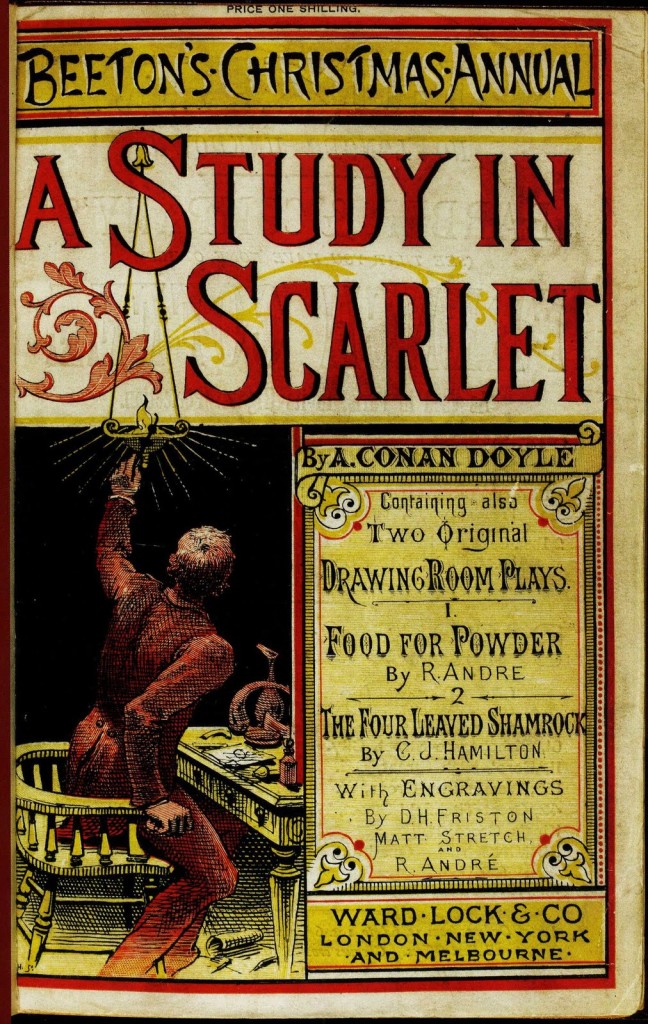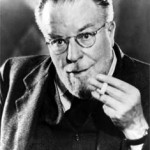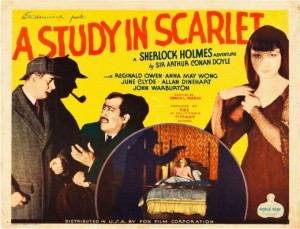A Scion Society of The Baker Street Irregulars

Data! Data! Data! A Study In Scarlet
“‘Data! Data! Data!‘ he cried impatiently. ‘I can’t make bricks without clay.’”
– The Adventures of the Copper Beeches (COPP)
This column is composed of material (Data!) developed for a short course called Appreciating Sherlock Holmes that I teach twice a year in the Community Education Life Enrichment Program for a local community college. It is composed of “points of information” that are common to many / most / all of the 60 Canonical stories.
The information here has been researched by me or borrowed / stolen from many efforts of other Sherlockians.
HERE GOES – This month’s story ……….A Study In Scarlet

CHRISTOPHER MORLEY SAYS . . .
 “A very unpleasant American is found dead in an empty house on a small street in London. There were no signs of a wound, yet the word RACHE was scrawled in blood on the wall . . . . Dr. Watson’s first introduction to the sordid and gruesome details of violent crime.”
“A very unpleasant American is found dead in an empty house on a small street in London. There were no signs of a wound, yet the word RACHE was scrawled in blood on the wall . . . . Dr. Watson’s first introduction to the sordid and gruesome details of violent crime.”
PUBLISHING HISTORY
- Chronologically, this is the first of the 60 Sherlock Holmes stories from Doyle’s pen to be published.
- The story was first published in Beaton’s Christmas Annual, 1887. The Illustrator was Doyle’s father, Charles.
- It was published in book form in 1888 by Ward, Lock & Co. (parent company of Beaton), London.
- A second edition appeared the following year and was illustrated by George Hutchinson.
- A year later in 1890, B. Lippincott & Co. released the first American version.
- Numerous further editions, translations and dramatisations have appeared since.
HOW MANY WORDS?
According to C. E. Lauderback, 1960 – – found on SHERLOCKIAN.NET website of Chris Redmond.
At 43,483 words, A Study In Scarlet has the 58th most words (#1 is The Veiled Lodger – 4,499, #56 is The Naval Treaty – 12,701)
THE BEST OF SHERLOCK HOLMES (How do Sherlockians rate this story?)
1927 – Arthur Conan Doyle – Not on his list of 12 favorites
1959 – Baker Street Irregulars – Not on their list of 10
CLASSIFYING THE CASE (From the Wandering Gipsies of Grimpen Mire of Decatur, Alabama)
This case is one of 23 classified as a MURDER and one of 14 where the perpetrator was either killed, arrested, or otherwise satisfactorily handled.
CHRONOLOGICALLY SPEAKING
Doyle was often very vague about stating WHEN the tale took place and included few contemporary references to help. Whether this was done intentionally or unthinkingly, the dating of events in the Canon is a very popular pastime pursued by several of our “scholars” researching and justifying their results to no end.
Once again we default to William S. Baring-Gould’s Friday, March 4 to Monday, March 7, 1881. This would make it the 3rd of the 60 stories. Only The Gloria Scott (1874) and The Musgrave Ritual (1879) preceded it in time.
HOLMES AND WATSON – PERSONAL INFO
Holmes and Watson were introduced by a common acquaintance, and took up residence together at 221B Baker Street. And so, the world’s most famous detective (and his Boswell) begin.
DRAMATIS PERSONAE
Our Primary Characters are introduced:
- Sherlock Holmes – A young man, age 27, with many strange habits, and unusual activities.
- John H. Watson – Recently from Her Majesties forces in India and Afghanistan, recently pensioned due to a war wound. (This is only one of four stories that mentions Watson’s First name.)
Two men playing a part vital to the plot and never heard from again:
- Murray – Watson’s orderly who saved his life at Maiwand
- Young Stamford – a former dresser under Watson who introduced him to Holmes
Two Scotland Yard men who turn up in various stories (abbreviations used) who are regularly assisted by Holmes:
- Inspector Tobias Gregson – STUD, GREE, WIST, REDC
- Inspector G. Lestrade – STUD, BASC, NOBL, EMPT, NORW, CHAS, SIXN, SECO, CARD, HOUN, BRUC, LADY, 3GAR
“QUOTABLE SHERLOCK”
This story is loaded with memorable quotes since everything is establishing the characters of Holmes and Watson. Plus it is one of the four long stories. Here are less than half of the quotes by Sherlock initially on my list.
- “London, that great cesspool into which all the loungers and idlers of the Empire are irresistibly drained.”
- “How are you? You have been in Afghanistan, I perceive.”
- “I have to be careful, for I dabble with poisons a good deal.”
- “I consider that a man’s brain originally is like a little empty attic. “
- “I suppose I am the only one in the world. I’m a consulting detective, if you can understand what it is.”
- “Gregson is the smartest of the Scotland Yarders. He and Lestrade are the pick of a bad lot.”
- “I’m not going to tell you much more of the case, Doctor. You know a conjuror gets no credit when once he has explained his trick, and if I show you too much of my method of working, you will come to the conclusion that I am a very ordinary individual after all.”
- “It is a capital mistake to theorize before you have all the evidence. It biases the judgment.”
- “There is nothing new under the sun. It has all been done before.”
- “They say that genius is an infinite capacity for taking pains,” he remarked with a smile. “It’s a very bad definition, but it does apply to detective work.”
- “The most commonplace crime is often the most mysterious, because it presents no new or special features from which deductions may be drawn.”
HOLMES’ FEE
Holmes told Watson: “Supposing I unravel the whole matter, you may be sure that Gregson, Lestrade, and Co. will pocket all the credit. That comes of being an unofficial personage.” Holmes then said he would work it out on his own hook, and have a laugh at them if nothing else. (Of the fully recorded cases there are at least nine, REIG, BLAC, SIXN, GOLD, ABBE, CARD, DYIN, STUD, and VALL, in which Holmes participated solely in order to assist the police.)
SHERLOCK ON THE BIG SCREEN & THE LITTLE SCREEN
1914 – A Study in Scarlet with James Bragington (theater movie – lost)
Never done by Eille Norwood, who did 47 stories

1933 – A Study in Scarlet with Reginald Owen (theater movie)
1933 – The Triumph of Sherlock Holmes with Arthur Wontner (theater movie)(mostly A Study in Scarlet)
1968 – A Study in Scarlet with Peter Cushing (TV episode)
1983 – A Study in Scarlet with Peter O’Toole (Animated TV movie)

2010 – A Study in Pink with Benedict Cumberbatch (TV episode – a pastiche)
Never done by Jeremy Brett in 41 episodes
SHERLOCK HOLMES IN DISGUISE
The Master of disguise used the deception of being disguised 14 times in 11 of the 60 stories – – but he didn’t use one in his first appearance.
UNRECORDED CASES (That involved Holmes)
Watson (Doyle) would tease / torture his readers with “I know something you don’t.” Oh my, how Sherlockians love this category. I have in excess of over 150 examples in my collection. Neither Watson nor Holmes discussed any unrecorded cases in this tale.
FAINTING IN THE CANON (courtesy of Sherlockian Karen Murdock)
Fainting is extremely common in the Canon, appearing, in some form, in 37 of the 60 tales. In 21 cases someone actually faints. In 22 cases someone almost faints. And in 5 cases someone pretends to faint.
In this tale, the “boots” at Stangerson’s hotel almost faints. Jefferson came close also.
HOLMES’S PUBLISHED & PROJECTED WORKS
Sherlockians love this topic and are regularly searching for these items. Holmes mentions published or projected works in 11 of the stories. Holmes tells Watson that he wrote The Book of Life – a published magazine article about the science of detection
NEWSPAPERS (Real and Fictional)
Though included in only 20 tales some of our more obsessed Sherlockians dote on this one. Since it was Doyle’s first story, he probably wanted to “connect” with his readers and so cited several.
- Daily News – Morning paper in London which was extremely liberal. Founded in 1846.
- Daily Telegraph (and Courier) – Morning paper of London which was Liberal until the middle of the 1880’s whereby it became Unionist. It became very popular for the middle classes. Established in 1855. Is considered the country’s “other paper of record.”
- Echo – London evening paper that was liberal in politics and near bankruptcy throughout its short career.
- Standard – One of the more popular papers. It was of a Conservative nature. Had a distinguished staff of writers in journalism and literature.
. . . there are more categories of “Data!” but you have suffered enough by now.
 Frank Mentzel, aka Merridew of Abominable Memory, is the current Gasogene of the Six Napoleons of Baltimore. His Appreciating Sherlock Holmes classes for the Community Colleges of Baltimore County, MD meet four times each during the spring and fall semesters, which would make it the second most active Sherlockian group in Maryland.
Frank Mentzel, aka Merridew of Abominable Memory, is the current Gasogene of the Six Napoleons of Baltimore. His Appreciating Sherlock Holmes classes for the Community Colleges of Baltimore County, MD meet four times each during the spring and fall semesters, which would make it the second most active Sherlockian group in Maryland.

Sorry, comments are closed for this post.